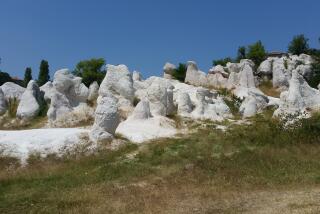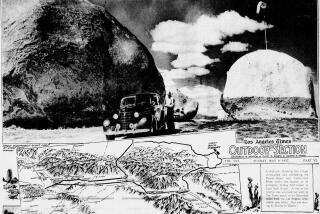In one small town, the human condition is etched in stone.
- Share via
ELBERTON, Ga. — In a placid field off Highway 77 stand six giant slabs of granite, at once mysterious and imposing, marked by engraved messages.
Erected in 1980 with stone from a local quarry and paid for by a stranger known only by the pseudonym Robert C. Christian, the structure draws visitors from around the world who gaze and read aloud from the inscriptions written in eight languages, dealing with improvement of the human condition.
Like Stonehenge in Britian, the mass of stone inspires awe and speculation. Why was it built? And who is Christian, really?
Put Town on Map
Some people describe the assembly, called the Georgia Guidestones, as a force for good, while others believe it is a tool for the devil’s work. Amid this debate, there is one certainty: The Guidestones, a monument of granite, also are a monument to granite. And they are putting Elberton on the map.
According to the Interior Department’s Bureau of Mines, Georgia produces 166,000 tons of granite a year, about twice as much as Vermont, its nearest U.S. competitor. Elberton, Georgia’s leading producer, modestly proclaims itself to be the Granite Capital of the World.
The town of 7,200 has 40 granite quarries, a granite museum, the requisite granite memorial to the Confederacy, a Granite City Bank, and a 20,000-seat football stadium called the Granite Bowl.
Even before the Guidestones came along, Elberton was on a roll. It annually rakes in $100 million from the sale of 200,000 or more gravestones, monuments and other memorials, including a sizable export business of raw granite to Japan.
Joe Fendley, chairman of the board of the Elberton Granite Finishing Co. and mayor of Elberton from 1980 to 1987, said his firm exported “in the seven figures” to Japan last year.
In 1979, the mysterious “Mr. Christian” paid Fendley “six figures” to build the Guidestones.
Fendley recalls being skeptical when the neatly dressed, soft-spoken Christian came to his office wanting “to buy a monument.” After Christian described the project, Fendley says his first thought was “I either got a kook on my hands or I got somebody with a lot of money.”
Despite some misgivings--Christian insisted on anonymity and is still known only to Fendley and a local banker who processed the check--Fendley took the job. He used 28-ton chunks of granite to create each of the six slabs and erected them on the highest spot in the county, a small piece of farm land purchased from 40 acres belonging to Wayne and Mildred Mullenix.
Four of the stones form a giant flywheel pattern around a center stone and a capstone. At a height of 19 feet, weighing about 119 tons each, they contain holes and slits angled to locate the North Star and mark high noon and the summer and winter solstices with spots of sunlight. Thus, the stones could “restart” the world’s compasses, clocks and calendars in the event of a nuclear holocaust.
Messages in 8 Languages
Ten messages, called Guiding Thoughts, appear on the four main stones in English, Russian, Mandarin Chinese, Arabic, Hebrew, Swahili, Hindi and Spanish. A sentence --”Let these be Guidestones to an Age of Reason”--is carved on the capstone in four archaic languages: Sanskrit, Babylonian cuneiform, classical Greek and Egyptian hieroglyphics.
The messages urge humanity to come up with a single language, to resolve external disputes in a world court, to “avoid petty laws and useless officials” and to “be not a cancer on Earth--leave room for nature,” among other admonitions.
The site is said to be at the spiritual center of the Cherokee Nation, and during construction, workers reported hearing strange music and voices.
“I’ve heard preachers say it’s evil,” said Hudson Cone of the Elberton Granite Assn., “and I’ve heard people say it’s the holiest spot on Earth.”
‘Poison Letters’
Fendley said, “I got a lot of poison calls and poison letters” over the years. Many of his detractors accuse him of concocting a scheme for self-aggrandizement, and inventing the character of Mr. Christian. Fendly denies the charges.
Whoever he is, Christian specified that the site remain “natural.” Not much has been done to make the site accessible. It has no parking lot, and the adjoining road is narrow. Nevertheless, thousands have made the trek to the old Mullenix field.
Naunie Batchelder, a psychic counselor in Atlanta, was married at the stones--between the Russian and English messages, she says. While the marriage ended in divorce, Batchelder maintains that “there is a special energy there, a healing energy. Granite magnifies it.”
Chris Clark, a college sophomore, said the stones have “stirred up a lot of talk about devil worship. My brother actually saw cars out there at midnight.” Friday the 13th, he said, is a particularly active night.
Mildred Mullenix recalls seeing “a clan of people camped out there. I call that odd, just to be camped out there in the middle of nowhere.”
As for mystic powers, she said, “It hasn’t affected me that way,” despite her home’s nearness to the stones.
But the mass has proved useful. “We use it as a reference point in directing people to our house,” she said.
More to Read
Sign up for Essential California
The most important California stories and recommendations in your inbox every morning.
You may occasionally receive promotional content from the Los Angeles Times.










